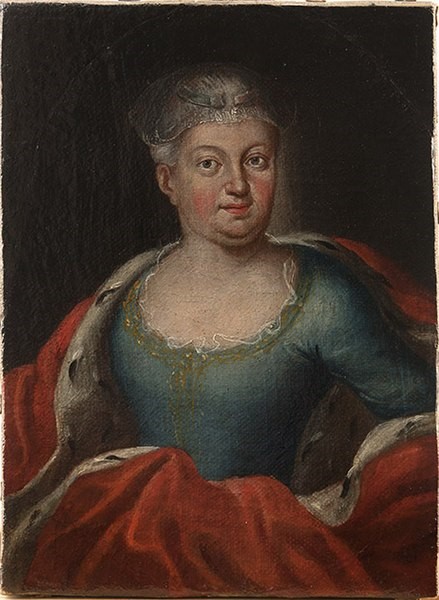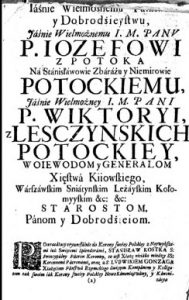Potocka Wiktoria, née Leszczyńska

Potocka Wiktoria, née Leszczyńska (1680 – 1 V 1732)
Parents:
Zofia Wiśniowiecka (1655-1681) and Wacław Leszczyński (1632-1688)
Siblings:
– Teofila z Leszczyńskich 1v. Konarzewska, 2v. Wiśniowiecka (1680-1757), wife of Janusz Antoni Wiśniowiecki (1741),
– Magdalena Działyńska nee Leszczyńska (d. 1706),
– Kazimierz Leszczyński (d. 1730), (wife- Magdalena nee Chodorowska)

Józef Potocki, paint. A. Manyoki,
Half-siblings:
– Stefan Leszczyński (d. 1722), 1st wife Konstancja nee Mniszech, 2nd wife Teresa nee Brzostowska 1v. Działyńska, 2v. Denhoff (d. 1738)
Husband:
from 1696- Józef Potocki (1673- 19 V 1751)
Children:
– Zofia (1697?-1729), wife of Adam Śmigielski. 2nd husband- Piotr Dominik Kossakowski,
– Stanisław Potocki (1698-1760), 1st wife- Marianna nee Łaszcz, 2nd wife Helena nee Zamoyska
– daughter NN (died after 1708)
– NN born V/VI 1709
Potocka Wiktoria, née Leszczyńska- wife of the voivode of Kiev, inherited vast lands in the Volhynian and Braclav provinces from her mother. Politically active, she participated, together with her husband, in many events of this period, especially since her husband Józef Potocki belonged to the opponents of King Augustus II and pursued his own policy, favouring Stanisław Leszczyński, a relative of his wife and Charles XII, king of Sweden. For some time Wiktoria Potocka stayed in Hungary, where she took refuge with her children, fearing her husband’s opponents. Potocka carried out broad charity and educational activity for the benefit of poor children – “having gathered poor orphans and given them a pious education, she sent some to monasteries for eternal divine service and others set up for marriage with a good dowry…” (pol. ubogie sieroty zebrawszy i pobożną edukacją wypolerowawszy, jedne do klasztorów na wieczną służbę boską wyposażyła, drugie z dobrym posagiem za mąż wydała…). A print issued on the occasion of the canonization of St. Stanislaus Kostka was dedicated to Wiktoria and Józef Potocki.

Victoria Potocka, née Leszczyńska died suddenly on May 1, 1732 in the summer palace of Belweder and was buried in Stanisławów on July 16, 1732 in the Jesuit Church. After Wiktoria’s death, her husband Józef Potocki married Ludwika née Mniszech, daughter of Konstancja née Tarło (d. 1739) and Józef Wandalin Mniszech (d. 1747), Grand Marshal of the Crown.
The Court:
The Potocki family made numerous investments in their private city of Stanisławów and the surrounding areas. Józef Potocki had the town hall reconstructed, the streets of the city paved, and the collegiate church in Stanisławów finished. However, the city suffered a lot of damage during the war, so after 1715 the Potocki family began rebuilding it again. The Jesuit College was also rebuilt and reformed in 1716. It played an important role in the education of young people, especially in the years 1730-1760. Wiktoria Potocka, née Leszczyńska had French and German classes added to the college’s curriculum in 1726. In 1720 the Potocki family founded a new Jesuit church and its furnishings were purchased using the income of Wiktoria Potocka, who allegedly sold her canary house (approx. 1000 canaries). It was here that a funeral service was held for their deceased daughter Zofia Kossakowska, née Potocki on November 17, 1729. As early as 1729, Wiktoria Potocka founded the main altar of the Immaculate Conception of the Blessed Virgin Mary and had the chapel and altar of St. Stanislaus Kostka decorated. She also provided the sacristy with liturgical vessels and vestments. The foundation of the church was supported, before her death, by their daughter Zofia Kossakowska, as well as their son Stanisław Potocki. The altars were made by the carpenter Józef Schraffl (1698-1751). However, the church was poorly designed and in the middle of the 18th century it had to be demolished and a new building was erected in its place. The Potocki family also had residences in Załoźce and Józefów. They were the founders of churches in Zbarazh, Józefów, and Tomaszów.
See also:
Popiołek Bożena, Kobiecy świat w czasach Augusta II. Studia na mentalnością kobiet w kręgów szlacheckich, wyd. II, Kraków 2018, s. 18 i nast. W Open Access- wydanie z 1996r. LINK
 Women's noble court in the Polish-Lithuanian Commonwealth in the Saxon times. Structure, people, culture, functions
Women's noble court in the Polish-Lithuanian Commonwealth in the Saxon times. Structure, people, culture, functions
